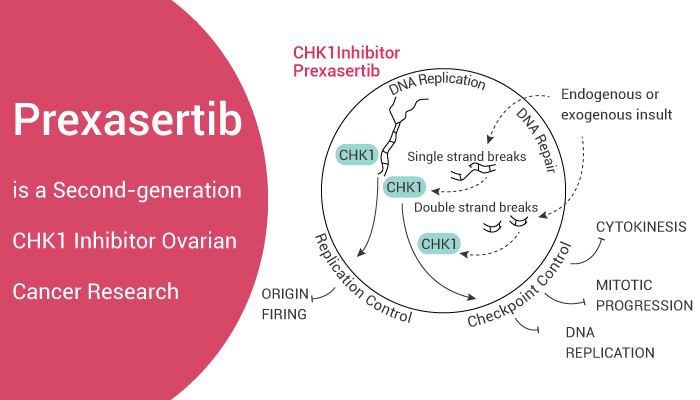Chk1 is a serine-threonine kinase, and plays a key role in G2M arrest, G1-S, intra S, and mitotic checkpoints. Usually, Chk1 is of high level in cancers, including lung cancer, ovarian cancer, breast cancer and leukemia, etc. Therefore, Chk1 inhibitors can be used for anticancer research. For example, Prexasertib (LY2606368), a selective and ATP-competitive CHK1 inhibitor, is now in phase 2 clinical trails for ovarian cancer (NCT03414047).

Prexasertib, a high-affinity CHK1 inhibitor, can causes double-stranded DNA breakage and replication catastrophe and has anti-tumor activity.
In vitro, Prexasertib inhibits CHK1 with a Ki of 0.9 nM and an IC50 <1 nM. Prexasertib also inhibits CHK2 (IC50=8 nM) and RSK1 (IC50=9 nM). In HeLa cells, Prexasertib (33, 100 nM; 7 h) results in DNA damage during S-phase. It also induces HeLa cell chromosomal fragmentation and apoptosis. Moreover, Prexasertib induces replication stress in HeLa cell, and depletes the pool of available RPA2 for binding to DNA. Besides, Prexasertib (4 nM; 24 h) results in a large shift in cell-cycle populations from G1 and G2-M to S-phase, and induces H2AX phosphorylation in U-2 OS cells.
In vivo, Prexasertib also shows antitumor activity in in tumor xenografts. Specifically, Prexasertib (1-10 mg/kg; SC; twice daily for 3 days, rest 4 days; for three cycles) inhibits tumor growth in CD-1 nu/nu mice bearing Calu-6 xenograft tumors. Prexasertib is well tolerated without obvious animal weight loss. When combined with BMN673 (0.33 mg/kg, p.o., one time daily, 16 days), Prexasertib (2 mg/kg, SC, 3 times/week, 16 days) shows synergistic anticancer effect in gastric cancer PDX model.
In conclusion, Prexasertib is a potent CHK1 inhibitor. Prexasertib can induce DNA damage and cell apoptosis. Moreover, Prexasertib alone or in combination with PARP inhibitor shows antitumor activity in tumor models.
Reference:
[1] King C, et al. Mol Cancer Ther. 2015 Sep;14(9):2004-1.
[2] Yin Y, et al. Am J Cancer Res. 2017 Mar 1;7(3):473-483.